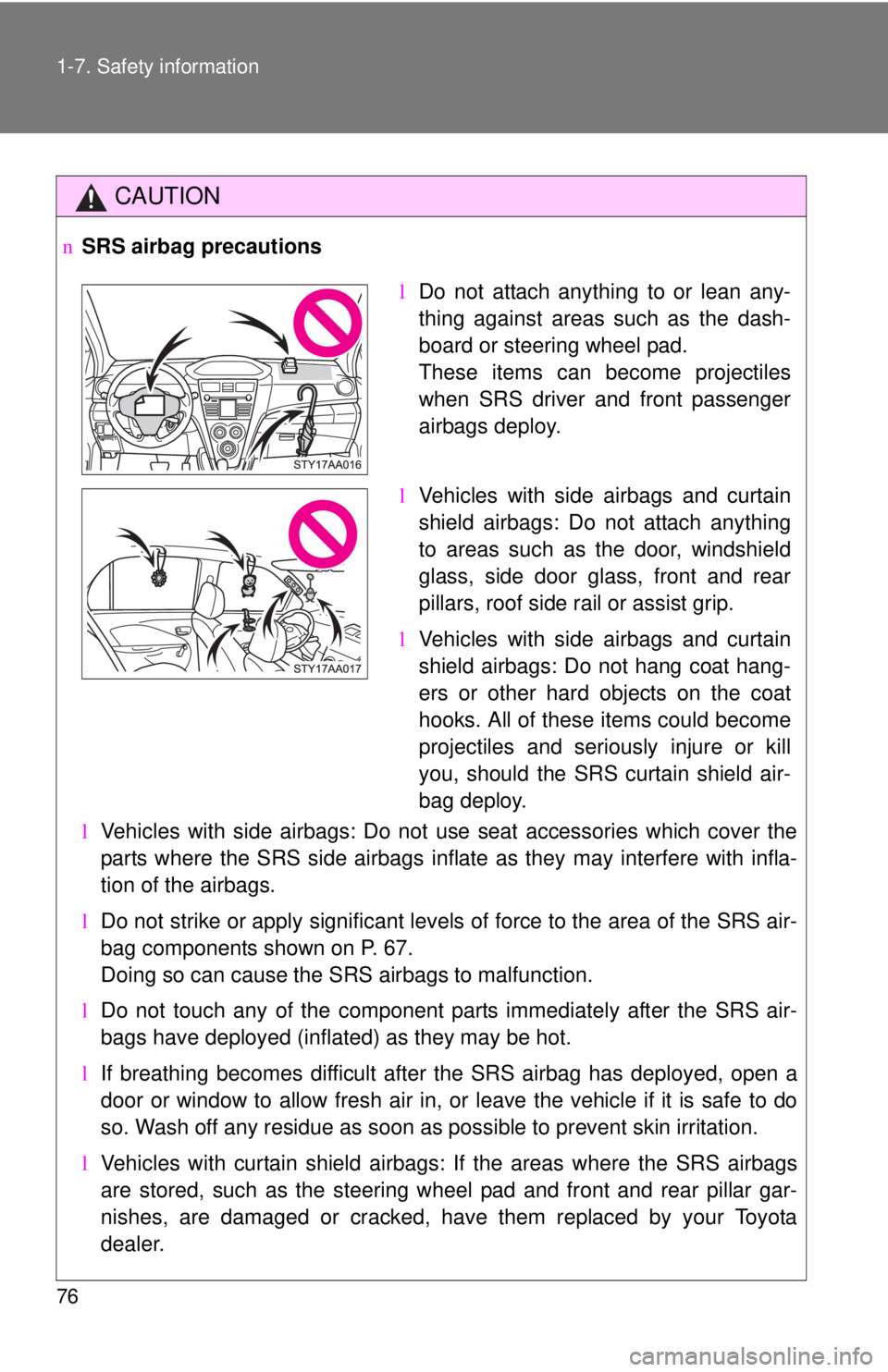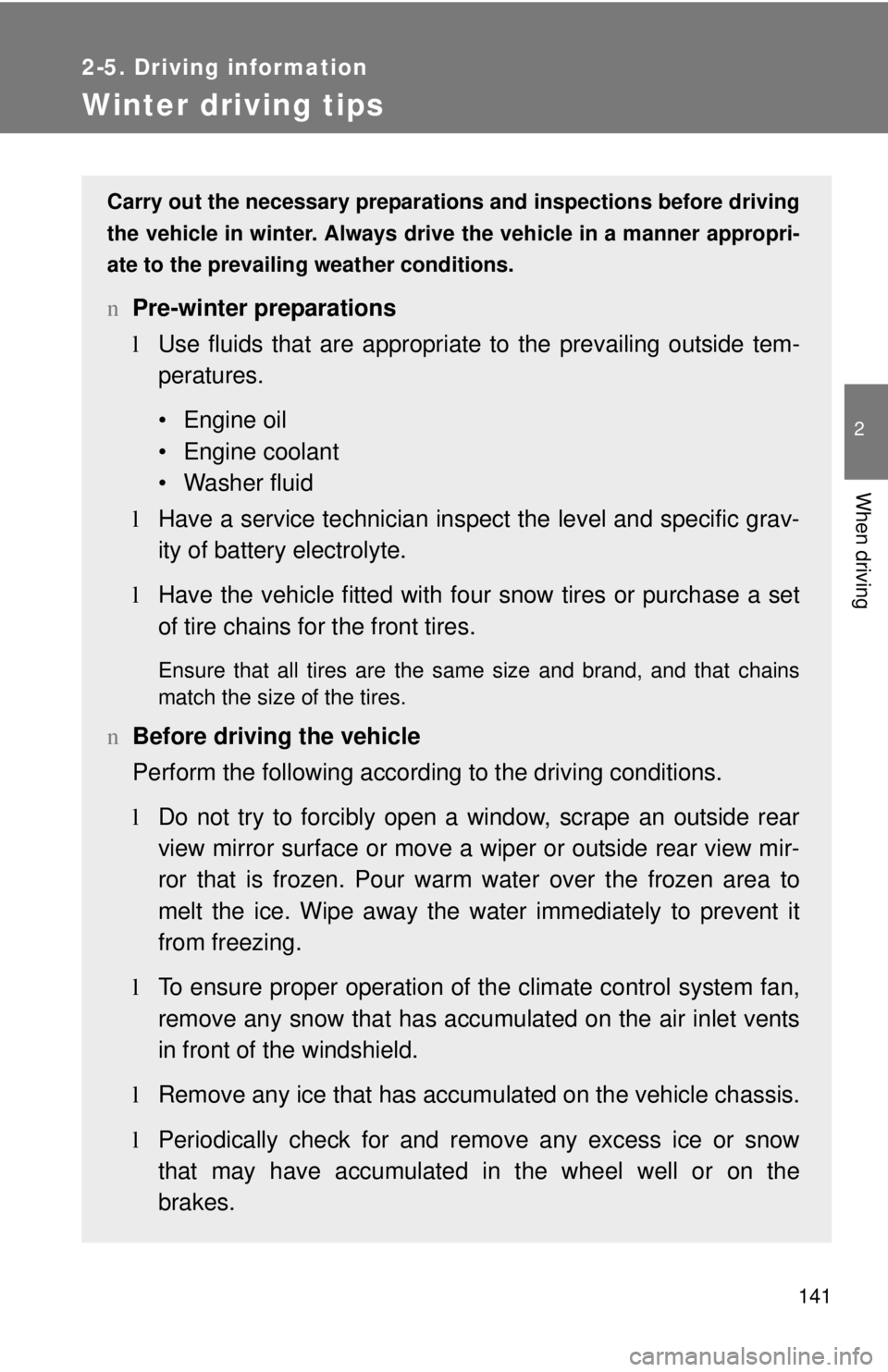Page 36 of 384
14
Pictorial indexInstrument panel
Rear window defogger switch ∗ P. 164
Air conditioning system P. 158
AUX adapter ∗ P. 189
Page 69 of 384
53
1
Before driving
1-4. Opening and closing the windows
Power windows (if equipped)
The power windows can be opened/closed using the following
switches.
Driver’s power window switches
Closing
Opening
One-touch opening (driver’s
window only)
*
*:Pressing the switch in theopposite direction will stop win-
dow travel partway.
Front passenger’s power window switch
Closing
Opening
Rear passenger’s power window switch Closing
Opening
Page 70 of 384
54 1-4. Opening and closing the windows
Lock switchPress the switch down to lock
passenger window switches.
Use this switch to prevent chil-
dren from accidentally opening or
closing a passenger window.
nThe power windows can be operated when
The engine switch is in the ON position.
n Operating the power windows after turning the engine switch off
(driver’s window only)
The power windows can be operated for approximately 45 seconds even
after the engine switch is turned off. They cannot, however, be operated
once either front door is opened.
CAUTION
n Closing the windows
Observe the following precautions.
Failing to do so may result in death or serious injury.
lCheck to make sure that all passengers do not have any part of their body
in a position where it could be caught when a window is being operated.
l Do not allow children to operate the power windows.
Closing a power window on someone can cause serious injury, and in
some instances, even death.
Page 78 of 384
62 1-6. Theft deterrent system
nItems to check before locking the vehicle
To prevent unexpected triggering of the alarm and vehicle theft, make sure
of the following.
lNobody is in the vehicle.
l The windows are closed before the alarm is set.
l No valuables or other personal items are left in the vehicle.
n Triggering of the alarm
The alarm may be triggered in the following situations.
(Stopping the alarm deactivates the system.)
lA person inside the vehicle opens a door, the trunk or hood.
l The battery is recharged or replaced when the vehicle is locked.
n When the battery is disconnected
Be sure to deactivate the alarm system.
If the battery is discharged before deactivating the alarm system, the alarm
may be triggered when the battery is reconnected.
Page 92 of 384

76 1-7. Safety information
CAUTION
nSRS airbag precautions
lVehicles with side airbags: Do not use seat accessories which cover the
parts where the SRS side airbags inflate as they may interfere with infla-
tion of the airbags.
l Do not strike or apply significant levels of force to the area of the SRS air-
bag components shown on P. 67.
Doing so can cause the SRS airbags to malfunction.
l Do not touch any of the component parts immediately after the SRS air-
bags have deployed (inflated) as they may be hot.
l If breathing becomes difficult after the SRS airbag has deployed, open a
door or window to allow fresh air in, or leave the vehicle if it is safe to do
so. Wash off any residue as soon as possible to prevent skin irritation.
l Vehicles with curtain shield airbags : If the areas where the SRS airbags
are stored, such as the steering w heel pad and front and rear pillar gar-
nishes, are damaged or cracked, have them replaced by your Toyota
dealer.
l Do not attach anything to or lean any-
thing against areas such as the dash-
board or steering wheel pad.
These items can become projectiles
when SRS driver and front passenger
airbags deploy.
l Vehicles with side airbags and curtain
shield airbags: Do not attach anything
to areas such as the door, windshield
glass, side door glass, front and rear
pillars, roof side rail or assist grip.
l Vehicles with side airbags and curtain
shield airbags: Do not hang coat hang-
ers or other hard objects on the coat
hooks. All of these items could become
projectiles and seriously injure or kill
you, should the SRS curtain shield air-
bag deploy.
Page 115 of 384

100 2-1. Driving procedures
Lightly depress the accelerator pedal at the same time as
gradually releasing the clutch pedal.
Release the parking brake.
nDriving in the rain
lDrive carefully when it is raining, because visibility will be reduced, the
windows may become fogged-up, and the road will be slippery.
l Drive carefully when it starts to rain, because the road surface will be
especially slippery.
l Refrain from high speeds when driving on an expressway in the rain,
because there may be a layer of water between the tires and the road
surface, preventing the steering and brakes from operating properly.
n Breaking in your new Toyota
To extend the life of the vehicle, the following precautions are recommended
to observe:
lFor the first 200 miles (300 km):
Avoid sudden stops.
l For the first 500 miles (800 km):
Do not tow a trailer.
l For the first 1000 miles (1600 km):
• Do not drive at extremely high speeds.
• Avoid sudden acceleration.
• Do not drive continuously in the low gears.
• Do not drive at a constant speed for extended periods.
n Operating your vehicle in a foreign country
Comply with the relevant vehicle registration laws and confirm the availability
of the correct fuel. ( →P. 328)
n Normal characteristics afte r turning off the engine
Approximately five hours after the engine is turned off, you may hear sound
coming from under the vehicle for several minutes. This is the sound of a
fuel evaporation leakage check and, it does not indicate a malfunction.
Page 116 of 384

101
2-1. Driving procedures
2
When driving
CAUTION
n
When starting the vehicle
Vehicles with an automatic transmission, always keep your foot on the brake
pedal while stopped with the engine running. This prevents the vehicle from
creeping.
n When driving the vehicle
lDo not drive if you are unfamiliar with the location of the clutch, brake and
accelerator pedals to avoid depressing the wrong pedal.
• Accidentally depressing the accelerator pedal instead of the brake
pedal will result in sudden acceleration that may lead to an accident
that could result in death or serious injury.
• When backing up, you may twist your body around, leading to a diffi- culty in operating the pedals. Make sure to operate the pedals properly.
• Make sure to keep a correct driving posture even when moving the vehicle only slightly, allowing you to depress the brake and accelerator
pedals properly.
• Depress the brake pedal using your right foot. Depressing the brake pedal using your left foot may delay response in an emergency, result-
ing in an accident.
l Do not drive the vehicle over or st op the vehicle near flammable materials.
The exhaust system and exhaust gases can be extremely hot. This may
cause a fire if there is any flammable material nearby.
l Vehicles with an automatic transmission, do not let the vehicle roll back-
wards while the shift lever is in a driving position, or roll forward while the
shift lever is in R.
Doing so may cause the engine to stall or lead to poor brake and steering
performance, resulting in an accident or damage to the vehicle.
l If the smell of exhaust is noticed inside the vehicle, open the windows and
check that the trunk is closed. Large amounts of exhaust in the vehicle can
cause driver drowsiness and an accident, resulting in death or a serious
health hazard. Have the vehicle inspected by your Toyota dealer immedi-
ately.
Page 156 of 384

141
2-5. Driving information
2
When driving
Winter driving tips
Carry out the necessary preparations and inspections before driving
the vehicle in winter. Always drive the vehicle in a manner appropri-
ate to the prevailing weather conditions.
n Pre-winter preparations
lUse fluids that are appropriate to the prevailing outside tem-
peratures.
• Engine oil
• Engine coolant
• Washer fluid
l Have a service technician inspect the level and specific grav-
ity of battery electrolyte.
l Have the vehicle fitted with four snow tires or purchase a set
of tire chains for the front tires.
Ensure that all tires are the same size and brand, and that chains
match the size of the tires.
nBefore driving the vehicle
Perform the following according to the driving conditions.
lDo not try to forcibly open a window, scrape an outside rear
view mirror surface or move a wiper or outside rear view mir-
ror that is frozen. Pour warm water over the frozen area to
melt the ice. Wipe away the water immediately to prevent it
from freezing.
l To ensure proper operation of th e climate control system fan,
remove any snow that has accumulated on the air inlet vents
in front of the windshield.
l Remove any ice that has accumu lated on the vehicle chassis.
l Periodically check for and remove any excess ice or snow
that may have accumulated in the wheel well or on the
brakes.